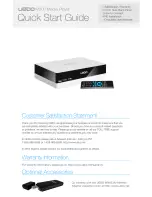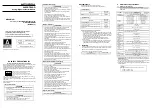
C2-2450A O
PERATION
M
ANUAL
51
returned means message was okay. ACK=0 returned means an error
was present in the message.
Bit 5 = 0 Reserved for future use.
Bit 4 = 0 Reserved for future use.
Bit 3 = 0 Reserved for future use.
Bit 2 = 1 This bit *must* be set.
Bit 1 = 0 Reserved for future use.
Bit 0 = 0 Reserved for future use.
CHA
(Channel)
SOURCE
or
MACRO
NUMBER
This byte has multiple uses, and defaults to 0 unless used for:
CHA
When a channel number is used in the Adjust Sources section (see
later).
SOURCE
Byte to indicate the source channel to be altered (if appropriate).
0x10 = RGB1, 0x11 = RGB2, 0x12 = RGB3, etc.
0x30 = CV1, 0x31 = CV2, 0x32 = CV3, etc.
0x40 = YC1, 0x41 = YC2, 0x42 = YC3, etc.
0x50 = SDI1, 0x51 = SDI2, etc.
0xD0 = OUT1, 0xD1 = OUT2, etc.
0xF0 = TC1, 0xF1 = TC2, etc.
MACRO
Or – for Macro related commands:
Bit 7..4 = 0 Reserved
Bit 3..0 = Macro number
WINDOW /
LOGO /
BORDER
Bit 7 = 0 (Reserved).
Bit 6..0 = Represents the window to be adjusted (for multi-channel units
only).
E.g. Window ‘A’ (the default for single-channel units) is sent as ‘41’
since 0x41 is ASCII for ‘A’. 0x61 is ASCII for ‘a’ (a Logo) and is sent as
‘61’.
OUTPUT
&
FUNCTION
HIGH
Bit 7..4 = Number representing the output to adjust 0 = Output 1, 1 =
Output 2 (for multi-channel units).
Bit 3..2 = Reserved (set to 0).
Bit 1..0 = Bits 9 & 8 of the function code. (Remainder of bits [7..0] are in
FUNC LOW.)
E.g. If the function code is 0x234, and we want to adjust Output 2, then
this byte is 0x12
FUNCTION
LOW
ASCII-hex byte to indicate the lowest 8 bits of the actual function to set
or receive (e.g. change Zoom value).
A later table details all the functions available.
PAYLOAD
x 3 bytes
A series of ASCII-hex bytes carrying the data to send.
Read requests have no payload - the payload is in the data sent back.
Write packets require a payload, and this is always in 'triple-bytes' - i.e.
3 bytes are required, MSB first.
e.g. '000001' is 1 in decimal, '010000' is 65536 in decimal, and
'FFFFF0' is -16 in decimal.
















































